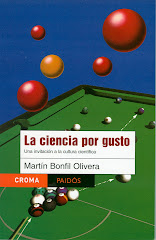April 22, 2009
 The mistery started on 1922: Australian explorer Thomas Griffith Taylor discovered on Victoria's land, Antarctica, a blood-colored waterfall that emerged from below Taylor's glacier (named in his honor).
The mistery started on 1922: Australian explorer Thomas Griffith Taylor discovered on Victoria's land, Antarctica, a blood-colored waterfall that emerged from below Taylor's glacier (named in his honor).Initially it was thought that the color was caused by algae, but today we know that it's due to iron oxides. What produces them?
The current sprouts at certain times of the year from a sub-glacier water deposit: a little buried lake 1,300 feet under the ice. The glacier, an ice river that flows with geological slowness, covered the lake of sea water, encapsulating it two million years ago. In its inside, today hiper-salty, there is no oxygen nor light.
Although it's not possible to enter the lake, by analyzing the water that flows in the waterfall Jill Mikucki and her team of researchers from the Land and Planetary Science at Harvard University (Science, April 17) have found, with support from NASA, genetic evidence of different types of bacteria ("a bacterial consortium") that use sulfur compounds to oxidize iron present on the rock under the glacier as medium to survive in a cold environment that lacks light and oxygen.
We are accustomed to think that life only exists if there is oxygen, but this is only true for modern organisms. Microbes like bacteria and their cousins the archaea are much more ancient, and have more versatile metabolisms.
Plants use solar energy to manufacture food from carbon dioxide from the atmosphere (then we, the other living beings, oxidize this food, combining it with oxygen, to obtain the energy stored in them). But there are other ways to survive. Antarctic bacteria obtain energy through sulfur compounds and in the process they produce iron oxides.
What's fascinating is that the same thing could have happened 700 million years ago, when the seas were covered in ice. And the same thing could be happening in other worlds, like Jupiter's moon Europa, under whose cold surface there may be a sea housing microbial life.
The moral of this story is: you never know what can be discovered when investigating a bloody mistery.
(translated by Adrián Robles Benavides)
To receive Science for pleasure weekly
in your email, subscribe here!




No comments:
Post a Comment